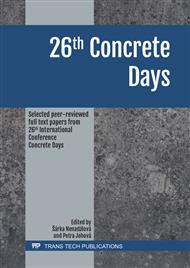p.31
p.38
p.44
p.51
p.57
p.62
p.68
p.73
p.80
Integrated Anchorage of Thin Façade Panels Made of Textile Reinforced Concrete
Abstract:
This paper discusses the feasibility of an innovative anchoring element which is designed to be integrated into the volume of an ultra-thin coffered façade panel made of textile reinforced concrete and to not increase its external dimensions. The first part of the article describes the composition and shape of the façade panel and focuses on the manufacturing of the composite anchoring element made of carbon technical textile penetrated with polymer matrix which is intentionally identical composition as in the case of the façade panel reinforcement. The second part of the article focuses on the behavior of the composite anchoring element and its effect on its surroundings during the mechanical loading of the façade panel. Specimens of the coffered façade panel with integrated anchoring elements were subjected to four-point bending test to determine the impact of the anchoring elements on the façade panel flexural tensile strength and type of failure. Additional specimens were tested to determine the load-bearing capacity of the anchoring elements.
Info:
Periodical:
Pages:
57-61
Citation:
Online since:
August 2020
Authors:
Keywords:
Price:
Сopyright:
© 2020 Trans Tech Publications Ltd. All Rights Reserved
Share:
Citation:


